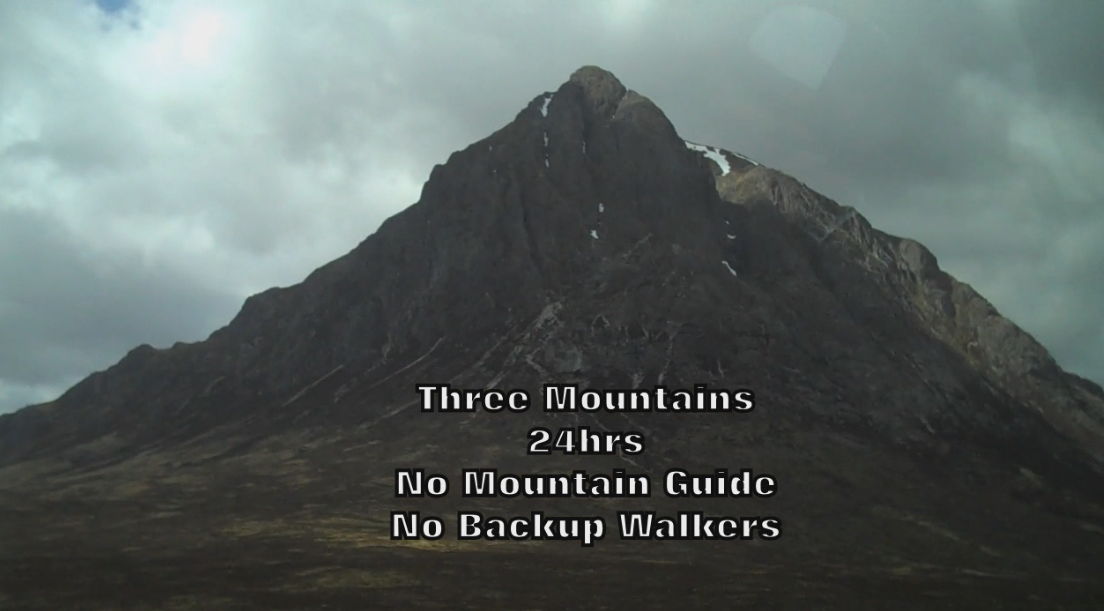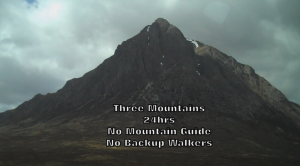National Three Peaks 2013 – The Full Story (part one)


23 hours and 8 minutes…
Numbers I’ll never forget.
And numbers I’ll never get tired of saying.
So, yes, it went pretty well. No exaggeration to say that it was a memory I’ll have for the rest of my life.
But, since memories fade, I figured it would be a good idea to write down as much of the experience as I can remember while it’s still relatively fresh in my mind. Apologies if the whole thing ends up being a little too granular; just remember this is as much for my edification as anything else.
Also, for the sake of people that may find this article looking for tips for their own challenge I’m going to colour-code some segments, with green indicating something I got right and red indicating a mistake I made.
If you want to go right back and read the details of my training and diet regimen, you can read all the older blog posts on the subject here: www.davidcongreave.com/category/three-peaks-challenge/
My father – my ultra-organised driver – and I drove up to Fort William on 22nd May 2013. It’s a long drive up there from Leeds so we set off at around 6am and arrived just after lunch. My intention was to begin sometime between 4pm-6pm the following day so we had plenty of time to get our bearings.
Driving up a day early and staying in a hotel added some expense but it avoided a very long car journey on the same day as the beginning of the event. The extra time really helped with the preparation. I also booked a small apartment, rather than a hotel room, as it allowed me to make use of the kitchen facilities for preparing and refrigerating food.
We arrived a little too early to check in straight away so we had something to eat at a Brewer’s Fayre pub (with a convenient gluten-free version of the menu – nice!) and then drove down to the start of the walk to check it out.
There are two obvious starting points to walking Ben Nevis. The first is from the tourist car park which makes for a slighter longer walk, albeit with a more gradual ascent at the beginning. The second is from the bridge opposite the youth hostel, which meets up with the first route after a short, but very steep, climb.
Desperate for anything that might save a little time I decided the youth hostel was the place where I would begin the following day.
The Ben Nevis information board on the other side of the bridge offered some ominous weather warnings and, most worryingly, suggested I allow a total of 7-8 hours for the ascent and descent. Given that my target time was 5.5 hours I began to get a little anxious.
One of my chief concerns about the whole event was whether I could keep up the kind of pace needed. My Scafell Pike and Snowdon test runs both came in over time and, although there were some mitigating circumstances, I couldn’t deny that my confidence was a little shaky.
Figuring out the start location was the last part of my plans so at least I was confident that I’d covered every part of my preparation as best as I possibly could.
The book “The National 3 Peaks : Taking Up The Challenge” was an invaluable read and covered virtually everything I needed to know. Some of the references in the back were a little out of date but this is still essential reading if you’re planning to organise your own challenge.
After checking into the apartment and unloading, we went to Morrisons to buy supplies. Deciding what food to purchase for the event proved to be tough. While most people can pick up sandwiches and pasta pots from service stations along the way, my gluten-free diet meant that I would have to prepare a lot more carefully.
Naturally I over-analysed and ended up buying things I didn’t need and not enough of the things I did, but more on that later.
Sleep was fitful that night. I kept waking up and going over the times in my head, again and again. I’m a little number-obsessed which doesn’t help…
The next morning I was up at around 7am and immediately went online to check the weather forecast.
It could hardly have been worse.
The forecast for Ben Nevis was rain, snow and gale-force winds.
When you plan your 3 Peaks challenge and book your accommodation and time off work you’ve no way of predicting the weather; really bad conditions can shut down your attempt before you’ve even begun.
This is why most people do their climb in late June or July, to give them the best possible chance of experiencing good weather. I chose May because I wanted to avoid the clogged roads that come during holiday season. It’s hard to say whether selecting an early date was a good decision or a bad one. From a weather perspective it was bad, but the roads did turn out to be relatively clear.
I now had a genuine quandary. Do I attempt the climb as planned, or do I delay the whole thing by 24 hours to when the weather forecast looked much better. Clive at Simon on the Streets (the charity for which I was raising funds) suggested starting early the next morning and finishing early hours of Saturday morning. It was a realistic suggestion and would simply require finding another night’s accommodation somewhere.
And yet I was just desperate to get started. It didn’t help that the weather outside the window was calm and pleasant. I’m not stupid enough to fail to realise that this was no indicator of the weather near the peak of Ben Nevis but was I being overcautious?
I agonised over the decision for most of the morning and settled on a compromise. I would set off as planned but turn back at the first sign of danger and restart the next day.
I felt better once I’d made my decision but then the nerves started to kick in. In just a few hours’ time I’d be setting off, on my own, to climb three mountains in 24 hours, starting with a mountain I hadn’t practiced on, in questionable weather conditions.
In the meanwhile I had some final preparations to do, starting with taking on as much fuel as possible. For breakfast I ate three extra-large hardboiled eggs and two toasted, gluten-free teacakes. For lunch it was back to the Brewers Fayre where I consumed half a roast chicken, coleslaw and two portions of chips.
I’d decided to begin at 4pm to give myself the best possible chance of getting up and down the first peak before dark. We ate lunch at around 12:30 which gave me a good three and a half hours to digest my meal. The second part of my plan was to sleep in the car for a couple of hours, until about 3pm, but this proved impossible.
I was back to the numbers again.
This time it was the Ben Nevis calculation. The descent is supposed to take 75% of the time it takes to ascend so that meant, if I wanted to complete the first peak in 5hrs 30min, I needed to reach the peak in about 3hrs and 10mins.
My realistic target for the ascent was 3hrs, so this would make the total 5hrs 15mins.
If you offered me that time I’d take it in a heartbeat.
My thinking was to aim for 5hrs, settle for 5hrs 30mins, but be prepared for the possibility that it might take me closer to 6hrs.
My timetable for the whole event had 90 minutes of wiggle-room built in, so taking longer than 5hrs 30mins would be disappointing but not disastrous. My estimates, based on Google Maps and the suggested times provided by the aforementioned book were:
Ben Nevis – 5.5 hours
Travel from Ben Nevis to Scafell Pike – 5.5 hours
Scafell Pike – 3.5 hours
Travel from Scafell Pike to Snowdon – 4.5 hours
Snowdon – 3.5 hours
Total Time: 22.5 hours
Simple, right?
At around 3.15pm we drove to the youth hostel and parked in the layby. I arranged my backpack, put on my walking boots, downed an energy shot (current thinking is that caffeine before exercise helps endurance – Google it if you don’t believe me), did some stretches and then walked over the bridge to the information board that I’d decided would be my starting point.
Nothing to do now but pace until the clock reached 4pm.
A word on equipment…
======
The boots I purchased were not the best; passable but not the comfiest. With hindsight I should have invested a little more.
Memory-foam insoles and gel tube bandages to cover my toes helped considerably. The only toenail I lost after the walk was one of the two toes that didn’t have protection (I should have ordered 3 strips rather than 2).
Packing a trowel in my backpack in case of a badly timed call of nature turned out to be unnecessary as the Imodium I took one hour before I started worked perfectly.
The hydration pack I purchased for storing my water was an excellent idea but, again, I should have spent a little more as the cheap product I purchased never lost its rubbery chemical taste. Nasty!
Full-length, arms and legs, thermal underwear worked perfectly. Only my extremities felt the cold at any point.
The GPS with graphic display was fantastic. It saved me losing time on at least two occasions and was great for peace of mind. Thank you to http://uk3peaks.com for the GPX files of the three peaks.
Walkie-talkies were also a nice idea. I was able to let my father know when I was about 30 minutes away so he had time to get himself and the car ready to leave as soon as I got back.
======
My father set the alarm on his phone for 4pm. This would be the official time-keeping device for recording my progress and, hopefully, my completion time.
The wind had picked up a bit as the day wore on and the temperature had dropped, but not enough for me to think about putting on my hat and gloves. My practice walks had convinced me that I was best wearing as little as possible until I absolutely needed it.
I could see some people walking on the path but everyone was on their way back. Not surprising given the time of day. If I’d been starting on a Friday or Saturday there would have been a number of other 3-peakers all starting around about the same time.
But right now, it was just me.
The 4pm alarm goes and I start walking.
